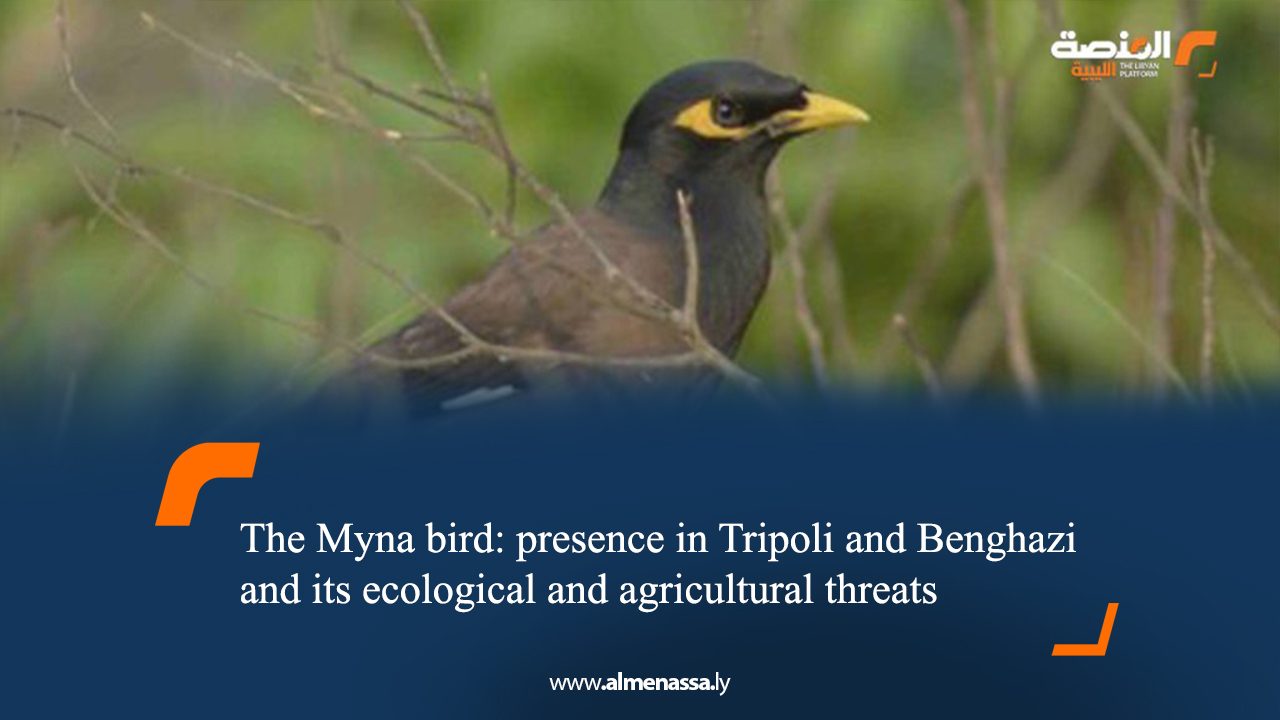Warnings are increasingly circulating on social media regarding the Common Myna, an invasive bird species in the Libyan environment that poses a significant threat to biodiversity, including humans, animals, plants, and the environment at large.
Habitat and characteristics:
This bird primarily inhabits Southeast Asia, Indonesia, China, India, and Bahrain. Its widespread presence and rapid proliferation are currently observed in eastern Saudi Arabia.
The Myna bird measures approximately 35 centimetres in length and is characterised by a dark, chocolate-brown plumage, a yellow beak, a distinctive yellow patch around the eyes, and yellow legs. A clear white area is visible on the underside of its tail and wings, forming a large eye-like pattern when observed in flight.
The Myna is a rapidly spreading and prolific breeder, with each female laying 2 to 3 pale turquoise eggs with brown spots. Both parents participate in incubating the eggs, a period that ranges from 16 to 17 days. Approximately 20 days after hatching, the young leave the nest to begin another breeding cycle. This bird is not restricted to a specific breeding season, contributing to its swift population growth.
International warnings and ecological threat classification:
The Indian Myna bird has been classified among the most threatening birds to local biodiversity and is considered one of the most dangerous invasive alien species. It is a carnivorous bird, distinguished by its aggressiveness and high competitive ability. It also possesses a unique capacity to mimic various sounds, including human speech, to a degree surpassing the ability and skill of parrots.
Global environmental organisations have categorised it among the top three birds most detrimental to ecosystems, given the harm it inflicts on the environment, humans, and animals. Similarly, the International Union for Conservation of Nature (IUCN) listed it as one of the three worst birds among 100 invasive species globally.
Despite its classification as an ornamental bird kept by many people in cages in their homes due to its beautiful voice, small size, and attractive colours, its ecological and health risks far outweigh its vocal prowess and aesthetic appeal.
Presence in Tripoli and Benghazi:
Approximately two years ago, the Myna bird was observed in Egypt, Syria, and several neighbouring countries. Last year, a pair was sighted in the Ain Zara district of Tripoli on June 19, 2024, among residential homes. Some residents confirmed the presence of a group congregating in a nearby landfill. Today, the same bird was observed in Benghazi, amid serious concerns about its rapid spread within Libyan cities.
Studies suggest that the entry of these species, originating from Asia where their native habitat lies, likely occurred through the pet trade, especially as Algerian traders confirmed that some had escaped from pet dealers. It is also not ruled out that they entered Libya naturally, particularly given their recorded entry into Egypt and rapid spread there since 1998.
Regardless of how the Myna bird spread or was introduced to Libya, it possesses immense adaptive capabilities that make it a strong and successful competitor in all environments. It poses a serious threat to the lives of native bird species in Libya if necessary and effective measures are not taken to curb its proliferation.
Environmental, agricultural, and health risks:
Experts have explained that the Indian Myna bird occupies the nesting sites of other native species, fiercely competing with them, destroying their nests, and killing their young. This negatively impacts the population and distribution of native species and significantly affects ecological balance. It also causes severe damage to crops and is considered an agricultural pest globally controlled. Furthermore, this bird contributes to noticeable noise pollution in urban areas.
Additionally, it poses a direct threat to agriculture and human interests, as it feeds extensively on livestock fodder and, particularly, fruit, and generally other tree fruits. It is a monogamous bird, meaning it settles in the same area throughout its life. This grants it the ability to identify the locations and homes of other birds, leading to constant conflict with native birds in the area to expel them and claim territory.
Studies have revealed that the bird’s nesting near residential areas leads to frequent noise complaints and concerns regarding public health and safety. It also carries serious diseases, such as avian influenza, Salmonella, and parasites like mites, which can cause dermatitis in humans.
Controlling its spread:
Some countries have begun to take clear and effective measures to combat the spread of this bird, after previously using it to control insect pests. The proliferation of this bird can be controlled and limited through the application of multiple techniques, such as periodic nest removal or methods to render eggs infertile. The importance of broad regional and international cooperation, as well as collaboration with specialised international organisations, cannot be overlooked for exchanging information and expertise on the best ways to control this invasive species. Strict laws must also be enacted to limit the transfer of this bird to new areas and prohibit its sale or ownership as a pet.
Amid growing concern over its spread in Libya after its presence was recorded in Tripoli two years ago, and its likely presence in Benghazi these days, coupled with its real and serious threat to the environment and biodiversity, there is an urgent need for vigilance from relevant authorities to take swift and well-considered measures before the crisis escalates and control becomes extremely difficult.


